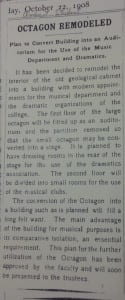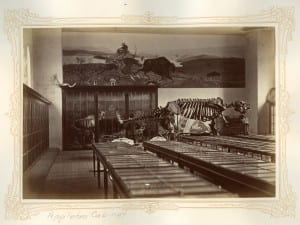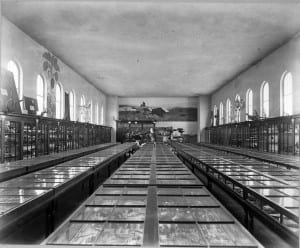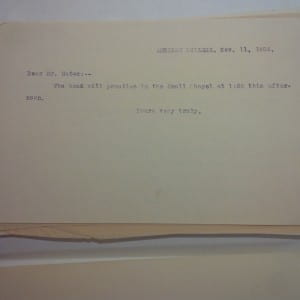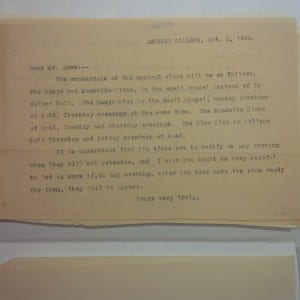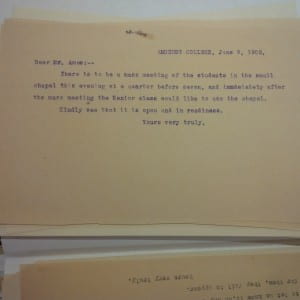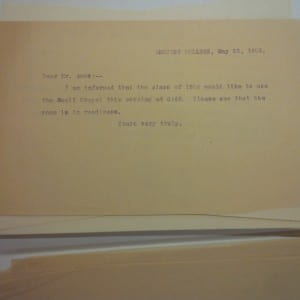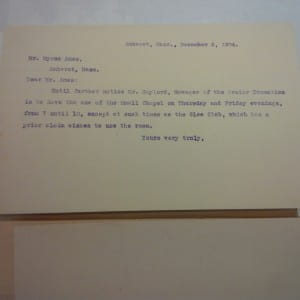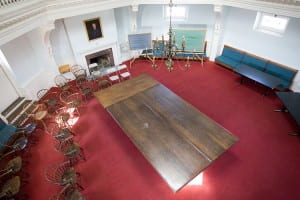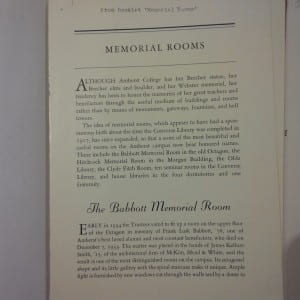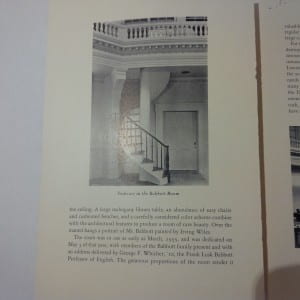1905 – The new observatory was built in 1903; by 1905, the Lawrence Observatory was completely defunct.
1908 – The observatory was officially out; the music department was officially in.

This was the start of a new campus trend – the Octagon was the first building on campus to be dedicated solely to the arts, as states George Frisbie Whicher, Professor of English, during the dedication of the Babbott Room twenty years later.
Appleton Cabinet received all the zoological and paleontological items of Hitchcock’s collections in the Woods Cabinet years prior, when Appleton was first erected.
The insides of Appleton Cabinet, complete with all Hitchcock’s former collections of the Woods Cabinet.
This gallery of slips shows the various purposes of the Octagon during this period.
At this point in the Octagon’s history, it moved from being the first specialized building to being used as a multi-purpose room, with many societies, clubs, and professors using the large space for their own purposes. The area, formerly filled collections, was cleared out and called “a small chapel.”
By 1925, major questions starting coming up about the 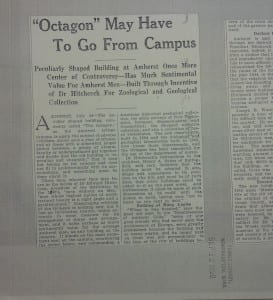 Octagon. Located on a “deformed” hill, with strange polygonal bizarreness, with a defunct tower and no longer used for its intended purpose, thoughts arose to remove the octagonal blight from the most visible part of campus and clean up the strict parallel lines of College Row.
Octagon. Located on a “deformed” hill, with strange polygonal bizarreness, with a defunct tower and no longer used for its intended purpose, thoughts arose to remove the octagonal blight from the most visible part of campus and clean up the strict parallel lines of College Row.
By 1935, a solution arrived. Frank Lusk Babbott (1854-1933) needed a memorial room; the Octagon had available space. Babbott was dedicated to assisting the faculty in their academic endeavors, and it only made sense to dedicate a room in his name to the faculty of the college. Thus, the Octagon was saved from the destruction that would befall its other many-sided brethren.
Images of the Babbott Room today and in the 20th century (from a booklet on memorial rooms at Amherst College)
Nowadays, the Octagon is used as a student space, acting as the meeting place the Black Student Union (formerly, the Afro-American Society), a classroom, a lecture space, an event location. Its walls no longer contains specimens of birds, minerals, and fossilized footprints; those have moved to the Beneski Museum of Natural History. The Nineveh Tablets are now the Assyrian Reliefs, and they too have found their space in the Kunian Gallery of the Mead Art Museum. Lawrence Observatory is more than 100 years defunct – but Wilder Observatory, just down Snell Street, is still functioning, searching for discoveries in space among the stars.
The purpose of the Octagon has changed dramatically, but all these elements still remain on campus. Hitchcock did directly influence the architecture; he gathered funds and people and swayed them for his scientific purpose. The unique and unmistakable building stands, not razed, not destroyed, not altered like so many others.
It stands as a testament to a dark time in Amherst College’s history, and as a tangible result of Edward Hitchcock’s influence on this institution.
May his dedication to learning, to education, to betterment continue in this institution.


